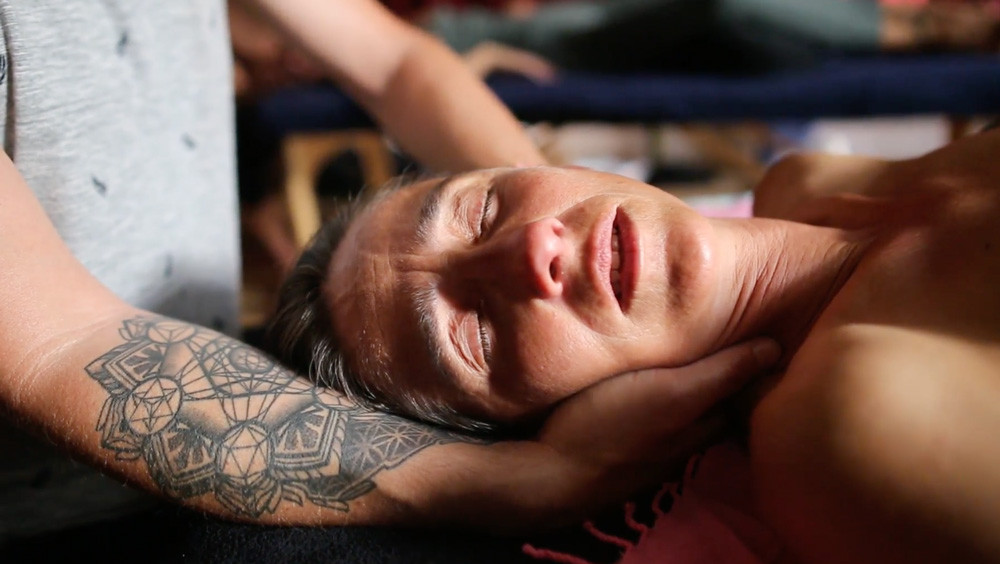
Working with Emotional Trauma in Bodywork Sessions:
Underneath most of our myofascial holding patterns is repressed emotional trauma. We know that emotional trauma is held in the soft tissues of the body. The concept of tissue memory is fundamental to our understanding of the connection between bodywork and emotional trauma release. Releasing emotions in sessions has a lot to do with the bodyworker’s intention as well as the character of the client. As bodyworkers who work hands-on with clients, we regularly see cases where trapped emotions are the underlying cause of many pain syndromes. We locate these emotions when we encounter areas of the body that are tight and where energy is blocked and fluid flow is restricted. If you have the intention of working with feelings, you will respond to sound, breath and movement and will verbally address one’s own feelings.
I have been working a lot with people's emotions
I went through a period of giving bodywork sessions when I was working with people’s emotions a lot. I was very interested in emotional awareness and expression. I was working with movement, breath, sound and emotional expression in conjunction with deep bodywork. I am aware that a large percentage of the holding patterns in the body are because of emotional repression, emotional denial and emotional avoidance. So when I am releasing the holding pattern in the back, I am also touching the emotional body. There is no way around it. When I am doing deep work on the back I am touching the emotional and psychological patterns that are held in the back.
Some basic rules to work with emotions as they emerge in sessions
The first rule is acknowledge and accept emotional expression.
First in order to work with other people’s emotions, it’s good to start working with your own. If you have a lot of denial, judgment and fear to move into your own feelings, it’s much more difficult to support others in theirs. So one might say that you have to start acknowledging and accepting your own feelings first. Now, that’s not easy. It sounds good but the fact is that we spend a lot of our energy avoiding, denying and judging our feelings.
Let’s say that you have your fingers deep in somebody’s back and you feel the tissue releasing and suddenly when the body starts shaking, the breath deepens and tears start to flow. What some bodyworkers and massage therapists do is just not acknowledge it. They keep on massaging as if nothing’s happening. That reinforces the person’s defense, that it’s not okay to have tears. That it’s not okay to be shaky. That is exactly what happened when they were growing up, their parents not accepting and acknowledging their sadness and fears. So, very simply, as a bodyworker all you have to do is make a verbal statement to say: “Oh, tears are coming, good.” Your body is shaking, “so allow it to shake”. You don’t even have to say “Ah, sadness is coming” as you don’t know if it may be sadness or gratitude. All you have to say is “Tears are coming, great! Let them come.” By speaking to the feelings you acknowledge what is happening, accept what’s happening and the person then feels noticed and safe.
It’s easier for most of us to work with people’s tears and more difficult to work with their rage.
Many of us are afraid of anger. Anger can be very scary, because we have been abused by anger. We’ve had negative experience with anger. Anger is a God-given emotion. It is one of nature’s gifts to us. Anger gives us strength when it’s moved in a healthy way. Anger gives us clarity. Anger gives us good boundaries; we can say no when we want. Anger gives us fire and passion. Many powerful and creative people on the planet are angry types. They have channeled that red energy in a positive way. When we repress our anger, we become victims. We become doormats, people can walk all over us. Repressed anger turns into self-judgment and self-hatred or judgment of others.
Working with people’s anger is important. First though it’s important that you work with your own anger. Don’t just read books about it, get in there and do some work with your anger. Anger is often difficult to work with in bodywork sessions. First of all the noise factor. The client might need to scream. If your session space is sound-friendly and it does not bother anyone, then great. But if you are working in a space were loud noise disturbs neighbors, one trick you can use is have your client scream into a pillow or a towel. I have done this many times. Also kicking and hitting on a table is often dangerous for the table. So I have the client express slowly, consciously. Slow motion movement supports anger release sometimes better than fast and strong movement, as the movement can be done more consciously. But if you want to work with strong fast movement have a mattress in your session space and bring your client down on the mattress.
The second rule is that feelings are not problems to be solved.
When feelings are coming up in your sessions you don’t have to think: “What would my therapist say? My therapist is so smart, what would she say?”.
Feelings are energy in motion, emotion. When you release the soft tissue with deep touch you are releasing the armor that is repressing the feelings. This can provoke the emotion that is held behind the armor. Tissue is not mindless, tissue is full of sensation, full of feelings and old memories. Fascia is rich with sensory nerves, in fact fascia has more sensory nerves than any other tissue in the body. So, as you release fascia you are waking up the body’s sensations. Helping your client drop down from their head into their body. Moving from the past into the present.
When you are good at working with feelings you are good at mirroring feelings, being present and centered and empathetic when feelings come up. You don’t have to say much; you just have to make a contact statement acknowledging the feeling or the physical response. A trap for bodyworkers is often to get involved with the stories that are connected to the feelings. Don’t ask what’s going on with your mother. That’s the worst thing you could do. Then you start to work with their story. And believe me, bodyworkers sometimes add a little primal therapy and start to try to work with the mother and the father. You don’t want to get involved with the story behind it. Stay within their bodily responses. Work with their movement, sound and breath. All feelings have a certain movement, breath and sound. When a person starts trembling and then that spontaneous release in the body, acknowledge it verbally by saying, “You’re trembling, good allow it.” That’s acceptance. You just say: “Good, allow it” and then you stay still and present and respond in the moment. And that’s it. In one way it’s very simple, you mirror with your presence, with your hands, with simple statements and with your heart. Get your head out of the way. Don’t try to figure out. What is happening the body is showing you what it is.
Free the restrictions through "Myofascial Unwinding"
MER uses a technique called “myofascial unwinding” that can help to locate and physically free the restrictions in muscle and surrounding fascial tissue that house traumatic memories. As a skilled bodyworker holds and unwinds these tissue tensions, memories may surface and release, causing the body to spontaneously “replay” body movements associated with the memory of the trauma. This release initiates relaxation, unlocking the frozen components of the nervous system. Such a shift marks the reconnection of the brain with the tissue housing the trauma, allowing transformation and healing to ensue.
Within the bodywork environment, with a competent and sensitive bodyworker, you have the ability to release and clear the pain and trauma of the past. When we start to let go of the pain of our past, we can embrace life in the present, and experience the love and beauty of living in the moment.
